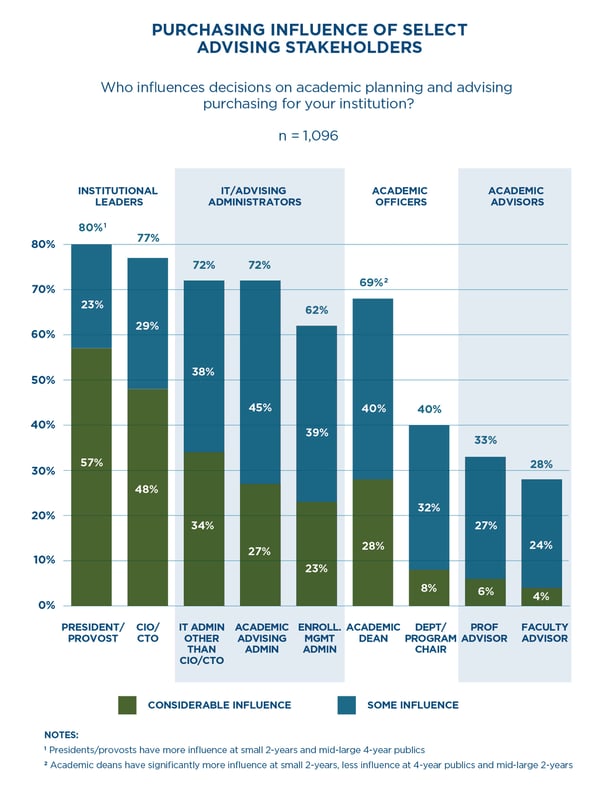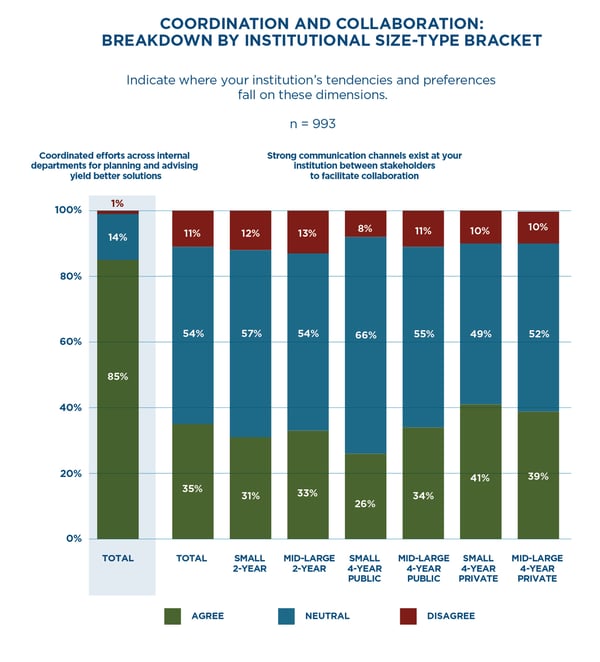Published on
Getting Advising Stakeholders on the Same Page: The Road to Improved Academic Advising (Part 3)

The number of stakeholders around campus involved in ensuring students receive sufficient planning and advising support is growing, making efforts more holistic, but more complicated. The growing emphasis on student success as a top priority for institutions means presidents, provosts, as well as campus IT leaders are joining the advising department to drive change. One indicator of this trend is that advising purchasing decisions are no longer siloed in the advising department. According to our June report Driving toward a Degree: Establishing a Baseline on Integrated Approaches to Planning and Advising, respondents reported that several groups have at least some influence on planning and advising purchasing decisions, including institutional leaders and IT administrators, as well as advising administrators, academic officers, and advisors themselves.
With more people playing critical roles in advising, institutions must ensure that stakeholders coordinate so that efforts build on each other and are not duplicative. Stakeholders we surveyed agree decidedly on this front: 85 percent of survey respondents agree that coordinated efforts on student success initiatives yield better outcomes.
Despite this consensus, just 35 percent of stakeholders reported strong communication channels exist at their institution to facilitate this kind of collaboration. While private institutions and, ironically, larger institutions (enrollment of 20,000+) reported slightly stronger coordination on student success, no segment of higher education exhibits this ability resoundingly.
There is evidence that stronger communication channels may enable institutions to enhance advising on campus. For example, institutions that have not adopted any advising technology at scale rate “lack of coordination across departments” as the second largest barrier to improving advising, below only “limited budget.” Thus, stronger communication channels may better equip institutions to introduce impactful solutions. What’s more, when responses to our survey are broken out by attitudes toward advising—including ownership, collaboration, technology use and outcomes—about 68 percent of respondents in the Equipped Navigator segment (noting institutions who are furthest along in reform efforts) reported strong communication channels at their institution, almost twice the response rate of the overall sample.
So, increasing coordination across stakeholder groups has the potential to bolster advising reform efforts. But how can institutions achieve this desired outcome? Institutional leaders should first try to understand the root of the breakdown in communication. From there, we recommend a few approaches below.
Action Step 1: Form a Coalition of Communicators
Having a dedicated group with representation across stakeholder groups can be an effective way to coordinate advising initiatives. In our first post on Leadership, Executive Director of NACADA Charlie Nutt discussed developing an advising council or network, and how that group can be an important communication vehicle. Since the advising council is often critical in developing the initial vision and goals for advising initiatives, it can also disseminate this vision across campus to ensure a consistent advising experience for all students. At Ramapo College in New Jersey, Christopher Romano, Vice President for Enrollment Management and Students Affairs, and Joseph Connell, Assistant Vice President of Student Success, established their Academic Advisement Council (AAC) with these goals in mind. Realizing that Ramapo lacked a holistic approach to advising despite some success in pockets of the institution, Romano and Connell initiated an advising council to develop a unifying strategy around student success.
An advising council should include broad representation across various stakeholder groups for maximum reach. Diversity of representation on Ramapo’s council, which includes professional advisors, faculty advisors, IT, and a close relationship with the faculty advisory board for their Starfish retention system, helps Ramapo maintain a 77-percent faculty adoption rate for the Starfish solution. Additionally, Romano and Connell say it is important to maintain a student-centered message in their communication across campus. To prepare for a roadshow of advising initiatives, Ramapo not only sought input from student representatives on their advisory council, but also surveyed first-year students through an in-house first-semester survey with over an 85-percent response rate. This allowed Ramapo to capture additional small wins or other insights to bolster their communication across campus. This type of student-centered message, shared by a diverse advising council, can broaden the reach of advising initiatives across campus.
Action Step 2: Make Coordination a Full-Time Job
At some institutions, especially two-year colleges, coordinating advising initiatives stretches across more than just one campus. In these cases, where collaboration can be increasingly challenging, dedicated resources may be required to build strong communication channels between advising stakeholders. At Austin Community College (ACC), Dr. Virginia Fraire, Vice President of Student Services and Wade Bradfute, Executive Dean of Student Services, previously relied on campus advising owners to coordinate and maintain consistency across the ACC system. However, when ACC grew from 5 campuses to 11 with over 45,000 total students, coordination became overwhelming. So Fraire worked with Bradfute earlier this year to establish two new roles focused on improving system-wide advising coordination.
Dedicated roles for advising coordination can lead to improved consistency of the advising experience and quicker decision making. Director of Academic and Career Advising Kathy James has played an integral role in increasing advising coordination through cross-campus meetings and training opportunities. For example, face-to-face team meetings of advising owners, which require a commitment of advisor travel time and expenses, have increased to a weekly cadence since James entered the role. Additionally, Coordinator of Integrated Advising Training Antonia Ceballos gathers challenges and technology enhancement requests from all campus supervisors, leading to quicker and more centralized decision making on improvements to advising systems. Bradfute believes this is making a difference, and is specifically seeing increased alignment in the advisor role across campuses. In our previous post on advising capacity, we discussed the need to analyze the return on advising investments. Roles dedicated to advising coordination, or other investments to improve collaboration, may return a more consistent advising experience and ultimately, better student outcomes.
Action Step 3: Make Process-Driven Technology Decisions
Advising technology has the potential to make processes more seamless, but it can also make them more complex. Campuses can alleviate the latter risk by prioritizing process early on during campus purchasing decisions. In another report we published, Driving Toward a Degree: The Evolution of Planning and Advising in Higher Education, we highlight ways that vendor solutions can and should help standardize and streamline processes, but also warn that technology alone should not decide the process.
The key is finding balance between preferred processes for new technologies and existing processes, yet this can be challenging. One way to ensure sound decision making is to involve a broader group of stakeholders, including advising leadership, in technology purchasing decisions. According to our research, the Equipped Navigator group is the only segment where academic advising administrators have purchasing influence more often than the CIO. If the campus advising voice is represented during purchasing decisions, stakeholders can illuminate current processes and reveal where technology should guide process changes or vice versa.
Tune in for next month’s post on advising technology, which will provide insights into adoption and implementation of planning and advising technology solutions that can impact student success. For more insights and resources, including interactive data, on advising reform, be sure to visit drivetodegree.org.
Author Perspective: Analyst





